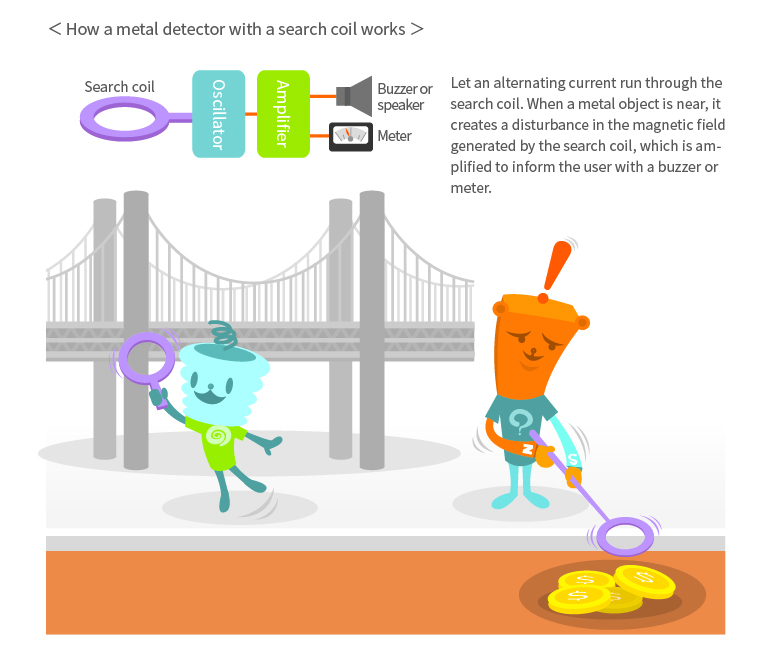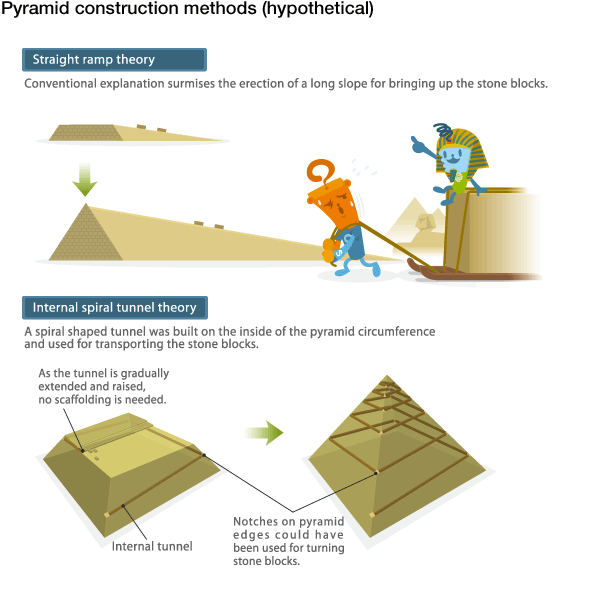
The Wonders of Electromagnetism
vol.2 Magnetic head technology paved the way for smaller hard disk drives with higher storage capacities
Home server: the heart of a home network
Only a concept not too long ago, home networks are now rapidly becoming a reality. These small-scale networks make use of wireless LAN technology to link not only computers and their peripherals but also various audiovisual products in the home, including TVs, HDD/DVD recorders, video cameras, digital cameras, audio equipment, and more. A central device in such a setup is the home server equipped with a large-capacity hard disk drive (HDD). The hard disks found in an ordinary personal computer usually do not have enough space for holding the enormous amounts of data that are involved when building up a large collection of videos, photos, and music. The home server on the other hand frees the user from having to worry about running out of space. These days, even home servers offering storage capacities on the order of terabytes (1,000 GB) have become very affordable. If the data volume of a newspaper for a year is taken as 333 MB, a terabyte is the equivalent of 3,000 years' worth of newspaper information, or one million photographs (counting a digital photograph as 1 MB).
Once the home network has been configured, data can easily be shared by all members of a household, using wireless access from any number of computers or other devices around the house. Via the Internet, it is even possible to access one's home server from outside the home. In the near future, this capability in conjunction with intelligent appliances such as air conditioners, refrigerators, and home robots will make our daily life even more convenient.
The basic components of a HDD are a magnetic disk spinning at high speed, and a swing arm that scans the disk for reading and writing data. Over the past 20 years, HDDs have made enormous progress in terms of providing increasingly large storage volume at ever smaller dimensions. Numerous technological breakthroughs in HDD head technology have made possible the amazingly high recording densities of today.
Manufacturing hard disk heads using thin film technology is a highly sophisticated process that exceeds even semiconductor manufacturing in complexity. A large number of head elements are first formed on a wafer in a thin film process and then broken up into separate chips called sliders (the slider end face is the head element). An arrangement of a slider mounted to a suspension is called an HGA (head gimbal assembly). Attaching a drive coil and other parts to the HGA results in the HSA (head stack assembly). TDK is a worldwide leader in this sector, employing a unified process that covers all stages from wafer manufacture to HGA and HSA assembly.
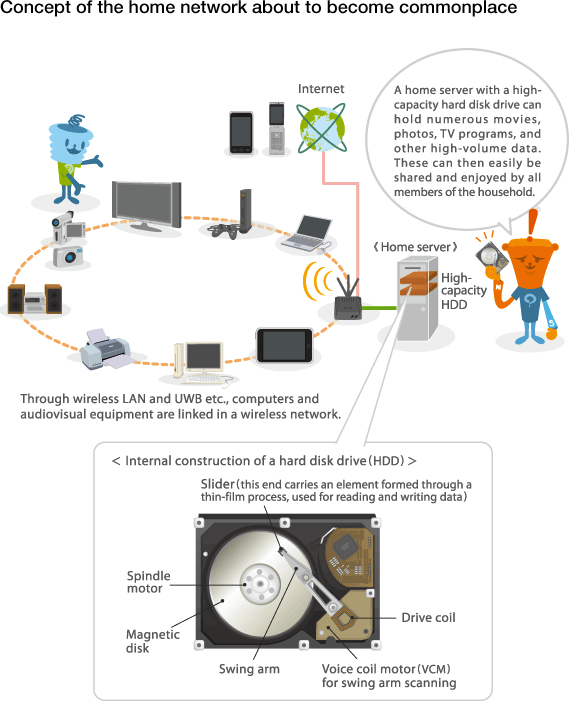
TDK was the trailblazer who made perpendicular heads with TMR read element a reality
Magnetic recording began with a copper wire recorder demonstrated by the Danish engineer Valdemar Poulsen in 1898. This device employed a head with a coil wound on a ring-shaped (C-shaped) core that was used to magnetize a copper wire and thereby record a signal. The heads used in magnetic tape recorders and video tape recorders basically employ the same principle, making use of the magnetic flux emerging from the gap of a ring-shaped head to magnetize the medium as it travels past the head.
In a HDD, the medium is not a wire or a tape but a circular magnetic disk. The first HDD in the world, developed by IBM in 1956 (called the IBM305 "RAMAC") was a behemoth that used an array of 50 magnetic disks, each with a diameter of 24 inches (about 60 cm). In spite of its enormous size, its storage capacity was a mere 5 megabytes, which is the equivalent of about four 3.5 inch floppy disks (2HD, 1.44 MB).
The recording density in magnetic recording is determined by the magnetic head. Just as it is easier to write small letters with a thin pencil rather than a thick brush, making the head gap more narrow enables the head to write more information to the medium. The narrower the head gap, the higher the recording density. However, because conventional magnetic heads were made by machining magnetic material such as ferrite and sendust, the manufacturing method imposed limits on how narrow the head gap could be. This meant that in order to increase storage space, making the disk diameter larger or packing in more disks were the only available options.
The next breakthrough in this area came with the development of the thin- film magnetic head. Thin- film process technologies such as photolithography and etching were harnessed to build up the head element in a multilayer structure. This enabled the realization of very high recording densities. In the 1990s, the development of new thin- film head types such as MR heads and GMR heads triggered another leap in recording density, helping HDDs to keep pace with Moore's law, an empirical observation which states that the number of transistors on integrated circuits doubles approximately every two years.
Furthermore, TDK was the first company in the world to overcome the limitations of conventional horizontal (longitudinal) recording by successfully bringing PMR (perpendicular magnetic recording) heads to market. By using a high-sensitivity TMR head for playback, the TMR/PMR head combo has enabled the realization of HDDs that offer even more storage capacity in a smaller form factor.
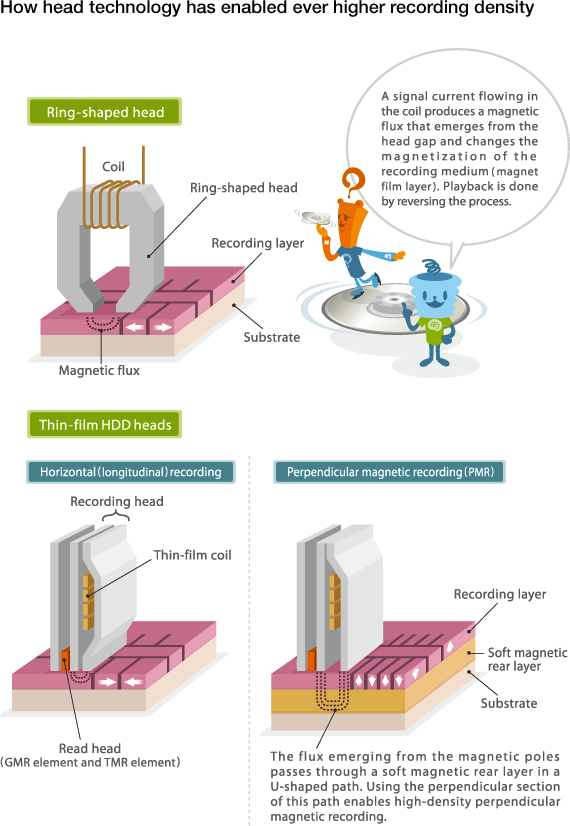
Next-generation thermal assisted magnetic recording using a near field light
The surface recording density of a HDD is expressed in bits per square inch (bit/in2). Thanks to a number of technological breakthroughs related to HDD heads, surface recording density has currently reached several hundred gigabits per square inch. In order to break the 1,000 gigabits = 1 terabit per square inch barrier, companies are searching for the next breakthrough. TDK has boldly taken up this challenge, with a new technology called thermal assisted magnetic recording (TAMR).
Magnetic recording in a HDD involves changing the orientation of tiny magnets that have been formed in the recording layer (magnetic layer), to store either a digital 0 or 1. With perpendicular magnetic recording (PMR), the recorded bits are densely packed in a pattern that is perpendicular to the disk surface. They retain their magnetic orientation due to their coercive force. As surface recording density increases, the magnetic bits become smaller which means that their coercive force needs to be higher in order to maintain thermal stability. This in turn leads to a situation where the recording head may not have enough power to write data.
Thermal assisted magnetic recording technology is an ingenious way to overcome this dilemma. It makes use of the fact that the coercive force of the magnetic bits becomes weaker as temperature rises. A laser beam is therefore used to heat the magnetic bit and reduce its coercive force in the moment when the magnetic flux from the recording head performs the write process. However, since the magnetic bits are smaller than the wavelength of the laser beam, a simple optical arrangement using lens based focusing cannot create a spot that is small enough for this purpose. This obstacle was overcome with the help of near field light technology.
When the aperture (opening) from which the laser beam emerges is made smaller than its wavelength, the beam will no longer pass through it. But by carefully designing the size and shape of the aperture, a tiny spot (about 50 nm in width) in the vicinity of the aperture can be created. This is called the near field light. By heating the magnetic bits with this near-field light and repeating the recording head write process at high speed, ultra high recording densities in excess of 1 terabit per square inch can be achieved. This is what thermal assisted magnetic recording does.
TDK has already developed the technology that will bring thermal assisted magnetic recording from the lab to the realm of practical application. Mass production is expected to begin within a few years. With the rapid expansion of cloud computing, the storage requirements of data centers are rising drastically, which in turn drives the demand for HDDs. With the next generation of super high- capacity HDDs in its sights, TDK is actively developing not only thermal assisted magnetic heads but is also working on various other highly advanced head technologies.
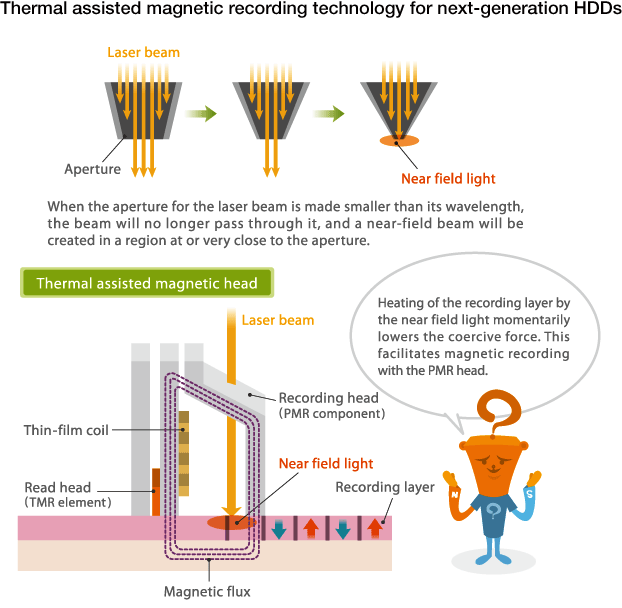
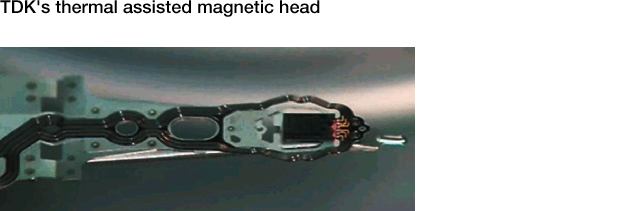
TDK is a comprehensive electronic components manufacturer leading the world in magnetic technology



